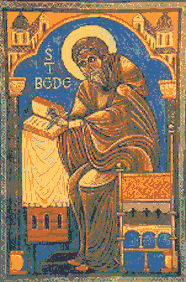Introduction
Born: Near St. Peter and St. Paul monastery, Wearmouth-Jarrow, England.
Died: 735.
Buried: At the monastery of St. Paul at Jarrow in 735. In 1022, his bones were brought to Durham. Then, in 1370, his remains were moved to the Galilee Chapel. This shrine was destroyed during the Reformation in 1540, and Bede’s bones reinterred in a grave where the shrine had stood.
